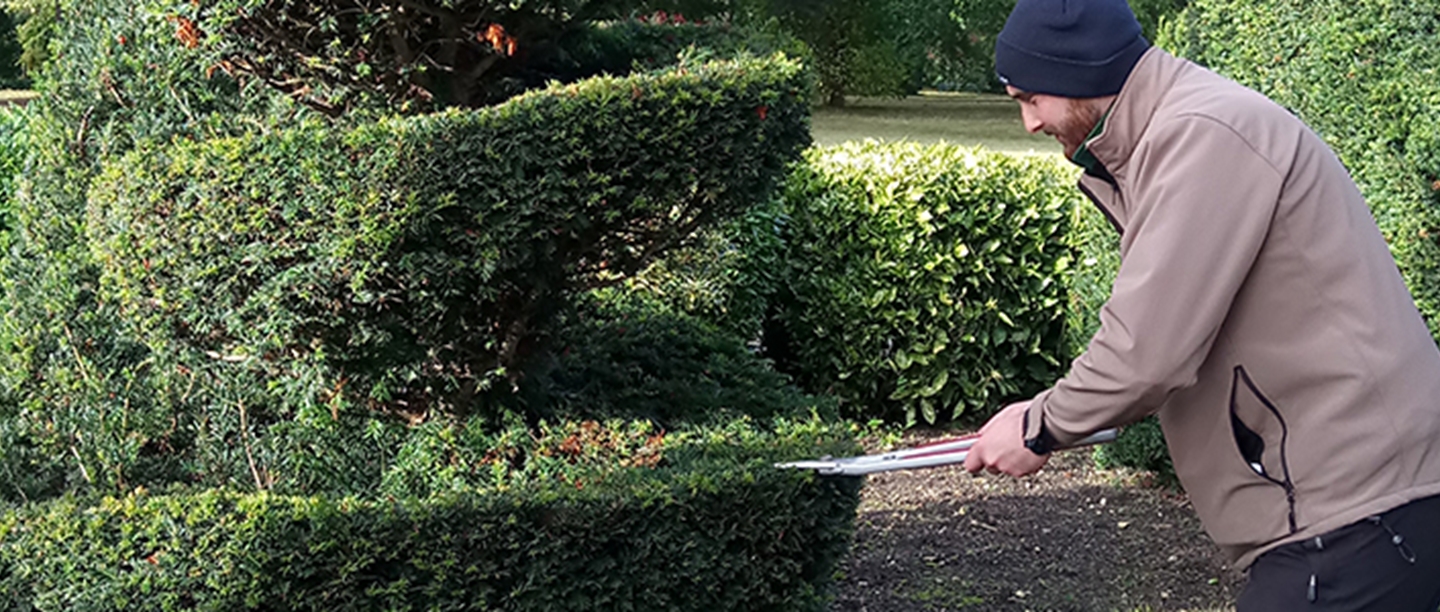
Topiary sculptures come in all shapes and sizes – from decorative balls and spirals to massive hedges and ornate birds and animals. Michael Klemperer, Senior Gardens Advisor, advises on how we sculpt and care for topiary creation in English Heritage’s historic gardens. And he shares tips for how you can create a topiary spiral at home.
You can get some inspiration from 5 historic gardens with fantastic topiary here, and learn more about the history of topiary too. Find out how topiary helped plant nurseries to develop in this country and when Lollipop trees became popular – amongst other things!
Which plants should I select?
Plants suitable for topiary are usually evergreen species such as box (Buxus sempervirens), holly (Ilex sp.), yew, (Taxus baccata), privet (Lingustrum japonicum) and other small leaved tight growing plants such as Lonicera nitida.
Other things to consider:
- What shape you wish to achieve
- The final size of your desired form
Remember, you’ll need to let the plant grow to larger, then prune down - The conditions of your garden
Soil type, weather, whether you’re planting in open ground or in a container
When starting a new topiary form, try to select a plant that approximates the shape you are trying to create. For example, cones or spirals require a straight central stem (known as a leader) upon which to shape your form. Where absolute symmetry is required, canes can be used to straighten stems. To achieve a number of identical shapes, for example in a formal parterre, wire formers can be used like a template to help create the same sizes and shapes.
Ideally pruning should be done in mid-June. If young growth is cut too early, bruising can occur. Often with tight and close-clipped shapes it may be necessary to trim a couple of times a year, the second cut being in late summer. With vigorous species and tight forms more frequent cuts will be required. With frequent light pruning the plants will develop smaller leaves and tighter growth which enables much stronger and cleaner forms to develop with time
Daniel Hale, Head Gardener at Brodsworth Hall, shows how to clip a topiary form.
Tools you’ll need:
- secateurs
- long handled sheers
- topiary sheers (which resemble those used to sheer sheep).
- For large scale work we also sometimes use mechanical hedge trimmers. It is wise to use an anti-bacterial spray to clean tools between individual elements as this helps prevent the spread of plat pathogens such as box blight
Forming and clipping a topiary spiral:
1. Use the long handled sheers to create a rough cut of your chosen form.
To do this, locate the central growing point of the stem which will become the apex of the form, then work away and down from this point. With balls, a length of garden wire twisted into a circular shape (slightly smaller than your plant) can be held over the foliage as you prune to form the perfect sphere.
The spiral shape requires one to start with a cone shape. This needs to be achieved on a plant with a strong strait leader.
To shape a cone, stand above the plant pruning downward and outward in a circular direction to achieve your form. A wigwam of canes secured from above and pulled in tightly with wire can help as a former.
2. Use string to define your spiral and start clippin
Working from the bottom, prune into the surface of the cone. You might want to use a string wrapped around your cone to define the fall of the spiral. Lift the foliage slightly and, as you do so, cut inwards towards the main stem. The angle of cut should get steeper as you progress up the plant.
3. Perfect the edges
Once your initial spiral is cut into the cone, define the upper and lower edges carefully with topiary sheers to form the perfect curved edge to the spiral.
Repairing a topiary sculpture or hedge
Existing topiary or hedges that have fallen in to disrepair can be brought back into shape by formative pruning. This can be quite hard, and doing a drastic cut back will give the appearance of a brown or scant branches. Afterwards the plant needs lots of feed to enable a new growth over time. Depending on species, after radically pruning new shaping can occur after a few years.
The ‘Cloud Hedge’ at Walmer Castle is a good example of a rescued topiary hedge. Damaged by a cold winter in 1947, pruning has helped the formerly formal hedge develop into an organic, undulating shape.
Finally it is worth while keeping a look out for box blight, box suckers or Phytophthora root rot on yews. These diseases will decimate your topiary, but can be controlled with careful treatment if caught in the early stages. Control of moisture via drainage, and good feeding will help massively in creating and maintaining topiary.
Find out more about English Heritage’s historic gardens
Visit our historic gardens hub for seasonal updates and ideas of places to visit.
Browse the gardens collection in the English Heritage online shop. As well as garden furniture and accessories, there are two topiary frames if you don’t fancy making a spiral. There’s a heart-shaped frame gift set and a squirrel frame to choose from.